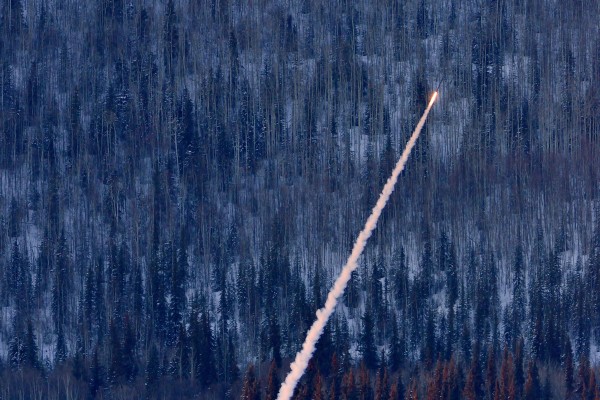Geophysical Institute researchers test small rocket
February 14, 2014

Ned Rozell
907-474-7468
2/14/14
On Feb. 9, 2014, a team of Geophysical Institute researchers launched a 10-foot carbon-fiber rocket on a seven-minute flight from Poker Flat Research Range north of Fairbanks. They fired the rocket to test its capabilities as a low-cost test vehicle for space physicists and other scientists who send missions through the aurora.
The small rocket, designed by Jeff Rothman of the Geophysical Institute’s electronics shop and envisioned by associate professor Mark Conde, arced to a predicted landing spot in the hills about one mile from the range.
The launch was a test of GPS, compass and radio communications systems Kristina Lynch of Dartmouth College plans to eject high in the ionosphere on a larger NASA sounding rocket.
Rothman and Conde see the smaller rocket, that reaches just three miles into the sky, as a low-risk way for researchers to test out instruments they hope to send hundreds of miles up on full-size NASA sounding rockets.
“If the payload works, it will probably work on a larger mission,” Conde said.
During the February test, the rocket had minor communications issues and a parachute ejected early. Neither affected the flight nor the safety of the rocket, but gave the researchers insight as they try to develop a business testing payloads.
“That’s the job of the rocket, to shake out issues like that,” Rothman said.
Conde, a space physicist who flies complicated experiments on full-size rockets, saw a need for the small rocket as a way for scientists to test intricate parts of rocket experiments with a launch that costs about $10,000 compared to the $1 million of a full-size rocket.
A few days after the launch of the six-inch diameter rocket, Rothman went out on snowshoes to recover it from a hillside about one mile from Poker Flat, 30 miles north of Fairbanks. He will troubleshoot the reusable rocket to determine what caused the problems.
After finding and correcting the problems with the initial flight, the next step for Conde and Rothman is to commission workers in the Geophysical Institute’s machine and electronics shops to design a 17.25-inch bulbous section for the small rocket that is the same size as payload sections on large NASA sounding rockets.
“Once they pass the test, you can almost literally unbolt it and put it on a big rocket,” Rothman said.
NR/2-14-14/197-14


